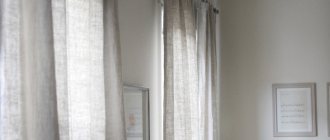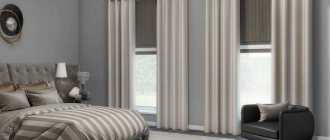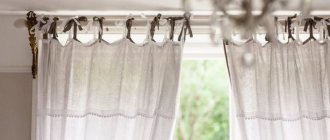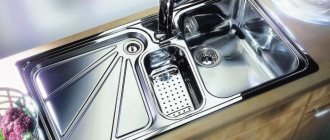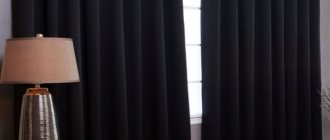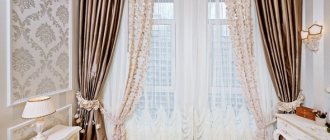Choosing the type of fastening
When choosing a method for hanging curtains from a curtain rod, you need to take into account several significant factors, namely:
- type of cornice - ceiling or wall;
- material density and curtain weight;
- general design of the room.
One of the important factors influencing the choice of fittings for attaching curtains is the type of cornice. If the cornice is fixed to the wall, the curtains can be hung using all possible methods: eyelets, hooks, clips, curtain tape, loops and others. The main thing is that the curtain moves freely and silently along the cornice. When installing a ceiling-mounted curtain holder, the choice of accessories is limited to hooks and curtain tape.
When choosing a hanging method, the density of the material and the weight of the curtain are of great importance. Light translucent tulle is best attached with small hooks or placed on a thin curtain braid. Eyelets or thick metal rings are not suitable for this type of curtain. But to hang heavy, dense curtains, you will need more solid fasteners, for example, iron eyelets, loops, rings, and strong hooks.
It is very important that the mounting method does not deviate from the overall design of the room. For example, curtain tape is perfect for any style, be it classicism, baroque, empire or more modern modern and minimalism. The method of hanging on rings, on the contrary, does not combine with classical styles and is better suited for techno or constructivism.
Braid
You can achieve ideal drapery at relatively low financial costs if you use braid (or curtain tape) as a curtain fastening, which is sewn on the inside of the fabric. With the help of braid, the fabric can be easily draped to the desired wave depth, which can be easily adjusted at any time. The hooks and loops are hidden behind the curtain fabric, making the curtain move easily along the curtain rod.
Curtain tape is equipped with one or two rows of loops, so it is suitable for attaching curtains made from heavy types of fabric. Curtains with braid are the optimal combination of aesthetics, functionality and cost.
Curtain tape
One of the simplest and most original types of fastening is curtain tape. What it is and how it works, the author of the GidShtor website figured out.
Many housewives still remember the times when many small loops had to be hand-stitched along the top edge of the curtain before hanging it on the curtain rod. Now the curtain tape performs the fastening function. It is a strip of material with one or two rows of loops and a cord for draping the fabric running along its entire length.
Ribbons made of transparent fabric are used for light curtains made of tulle and organza. Durable braid made of dense material is more suitable for attaching heavy curtains.
The principle of operation of curtain tape is very simple. The strip is sewn along the upper edge of the fabric and, by pulling the lace, it is gathered into folds, after which it is hung on the hooks of the cornice.
Important!
To get a lush drapery, the material for the curtain must be taken with a large margin, 1.5-2 times the width of the window opening.
Attaching to the cornice using curtain tape has many advantages:
- versatility - the method is suitable for any type of cornices;
- strength - the tape holds both light and dense fabrics equally well;
- low cost;
- the simplicity of the device - any housewife can sew the tape to the material.
In addition, it is necessary to note the long service life of such fastenings. The curtain tape will never fail, and when replacing curtains, it can be torn off and used again.
How to choose a curtain rod
If you plan to install a curtain rod made of metal at home, then it is recommended to take into account a number of nuances. As a rule, the selection criteria include size, strength level, equipment, shade, design. It is important to consider several recommendations:
- Before purchasing a product, it is recommended to first take measurements of the window opening. To the result obtained, you will need to additionally add about 25-30 cm (at least). This is necessary so that it is possible to open the curtains completely and not prevent daylight from entering the room.
- Many designers recommend giving preference to long rod curtain rods, which will significantly lengthen narrow window openings. In this case, the product should be located from one wall of the room to another with a minimum distance of up to 5 cm from each wall. Since the canvas will cover a fairly large part of the wall, the effect of large windows will be created.
- During the selection process, you should pay special attention to the configuration: the presence of brackets and rods. Otherwise, you will have to purchase them separately or look for another model. They must be of the required size and high quality.
As a rule, the dimensions of the brackets should be chosen based on the length of the window sill. If the length of the bracket is much less than the width of the window sill, then after installation it will be possible to observe an unsightly bend in the curtains. To prevent such a situation, it is recommended to choose fasteners whose length can be adjusted if necessary.
Advice! In order to significantly reduce the size of the window opening, it is recommended to purchase rod curtain rods of the same size as the window.
Materials for manufacturing rod curtain rods
A rod curtain rod is considered a fairly functional accessory, which is used for attaching curtains. Such elements may differ in their decorativeness, as a result of which they should have an attractive appearance and fit perfectly into the interior design.
In the selection process, consumers pay special attention not only to size, shape, decorativeness, but also to the material that was used in the production process of products.
The manufacturer offers rod models for sale, for the production of which the following materials were used:
- wood is the most popular option, which many consider ancient; the demand is due to the high level of strength, environmental friendliness of the material, and resistance to external factors;
- metal - such models can have a wide range of products, in addition to a variety of shapes and sizes, the product can have a gold or silver tint; predominantly aluminum is used in manufacturing;
- forged - a distinctive feature of such rod structures is the ability to withstand fabrics of any weight, and since these models are made by hand, they can be considered exclusive, since it is unlikely to find analogues.
In this case, the choice depends entirely on financial capabilities. As a rule, forged products have a high cost, while wooden models are a budget option.
Design options for rod curtain rods
Depending on exactly how many panels will be attached, you can choose a rod cornice of a suitable design. As a rule, models with 1 or 2 rows are offered for sale on the market of goods and services. Thanks to this option, it is possible to install not only light curtains, such as tulle, but also thicker fabric, which will protect against direct sunlight entering the room during the daytime. In addition, it is possible to install additional decorative elements.
Eyelets
Not so long ago, fastenings for curtains called “eyelets” came into fashion. They are a structure consisting of an upper - outer - ring with a recess around the perimeter and a lower ring with a sleeve.
In the upper part of the curtains, holes are made at the required distance from each other into which metal or plastic eyelets are inserted. Through these holes the curtain is strung onto the cornice.
A stylish and original device allows you to highlight the beauty of the material from which the curtain is made and create a beautiful drapery of the fabric. The folds are smooth, voluminous, and identical in size.
Fastenings for curtains in the form of grommets have the following advantages:
- have a respectable appearance;
- provide easy movement of curtains along the cornice;
- allow you to create beautiful folds and tails;
- Suitable for all rooms, from the kitchen to the nursery.
However, eyelets also have their drawbacks, which must be taken into account when choosing accessories for hanging curtains:
- high cost of devices;
- difficult installation - curtains can only be equipped with this type of fastening using a special press, so it is better to entrust the work to professionals;
- difficulty when using eyelets for hanging weightless fabrics such as organza or tulle;
- noise when moving metal rings along the cornice.
Advice
When choosing the color of the eyelets, you should focus on the tone in which the cornice is painted. For a white cornice, white eyelets are suitable; for metallic ones, the eyelets should be painted to match the metallic color.
Eyelets - elegant and modern
Eyelets are rings through which the cornice is threaded; they hide the holes in the textile. This is a spectacular, elegant and convenient type of fastening that emphasizes the modernity of the interior. It is well suited for curtains made of heavy, dense fabric.
Advantages of eyelets:
- look very impressive;
- allow you to make folds and draperies even and equidistant, voluminous and beautiful;
- glide easily along the cornice;
- goes well with different types of curtains, drapes and drapes;
- ideal for a children's room, since the baby is unlikely to be able to tear the curtains off the curtain rod.
However, it must be taken into account that eyelets are the most expensive option for fastening textiles. In addition, it is not advisable to use them for attaching curtains made of light fabrics. The main disadvantage of this type of fastening is the difficulty in removing curtains for washing.
Only a tubular cornice is suitable for grommets - only in combination with it will the curtains look neat. Designers also advise choosing the color of the eyelets for the cornice - for example, if it is brown, then the fastenings should be the same.
Rings
A very simple and functional way to hang from a cornice are metal and wooden rings. They differ from eyelets in that they are located not inside the canvas, but outside. Rings can only be used for round curtain rods.
The curtain is attached to the ring in different ways:
- using hooks, one end of which is sewn to the canvas, and the other clings to the ring;
- sewn to rings;
- hung using curtain tape and curtain hooks.
Such curtains move easily along the cornice, although they make a little noise. The fastenings are strong and wear-resistant, curtains can be made of any type of material. They are easy to fit into beautiful tails, and sewing such textiles does not require professional skills.
Clips and clamps
Clips and clamps are universal fasteners for curtains. In order to hang the curtain with clips, you will not need to sew on ribbon or loops. Often such fittings are made with decorative inserts and can be used as an independent element of room decoration.
The clips are very easy to use. To remove the curtain for washing, simply release the clamp and remove the fabric.
The disadvantage of this type of fastening is the slight noise that appears when the device moves along the cornice, and the inability to use heavy, bulky curtains for hanging.
Curtains with ties
Curtains with ties are made from lightweight materials in light shades with a simple printed pattern in the form of flowers or peas. Ties are sewn along the upper edge of the curtain, and they must be so strong that they can easily support the weight of the curtain.
You can use braid, multi-colored ribbons, or parts of rope as ties. You can sew the ties yourself from any suitable type of fabric.
Most often, decorating curtains with ties can be found in a teenage girl’s room, bedroom or kitchen. Everywhere they create a light romantic atmosphere.
Curtains with hinges
This type of fastening consists of decorative loops, sewn from the same material as the curtains. The loops can be sewn at both ends to the edge of the curtain, and then in order to hang the curtain on the curtain rod, you will have to thread the rod through the loops. Some needlewomen sew loops with buttons or Velcro. Removing such curtains is not difficult, you just need to unfasten the fastening.
Fastenings in the form of loops have the following advantages:
- easy to make with your own hands;
- even if such textiles are sewn by craftsmen in an atelier, the work will be inexpensive;
- create a cozy, relaxed atmosphere;
- There are no restrictions when choosing a cornice.
Hinged curtains do not require a standard curtain rod in the form of a round rod. They can be hung on a corrugated or square profile. When choosing a fabric for such a design, you need to pay attention to the elasticity and flexibility of the fabric, otherwise moving the curtain along the curtain rod will be inconvenient.
Clips - for light curtains
A good type of fastening for cute kitchen curtains. In other cases, we do not recommend using this type of fastening - it is somewhat old-fashioned and impractical. Fastening the curtain to the curtain rod using clips is very simple - just “grab” the upper edge of the fabric with the fastenings. If desired, you can add folds to the curtain.
Clips are made of metal or plastic. The main disadvantage of such fittings is the presence of teeth, which, on the one hand, prevent the fabric from slipping out when the curtain moves, and on the other, can damage it. Therefore, you need to remove the clips carefully.
